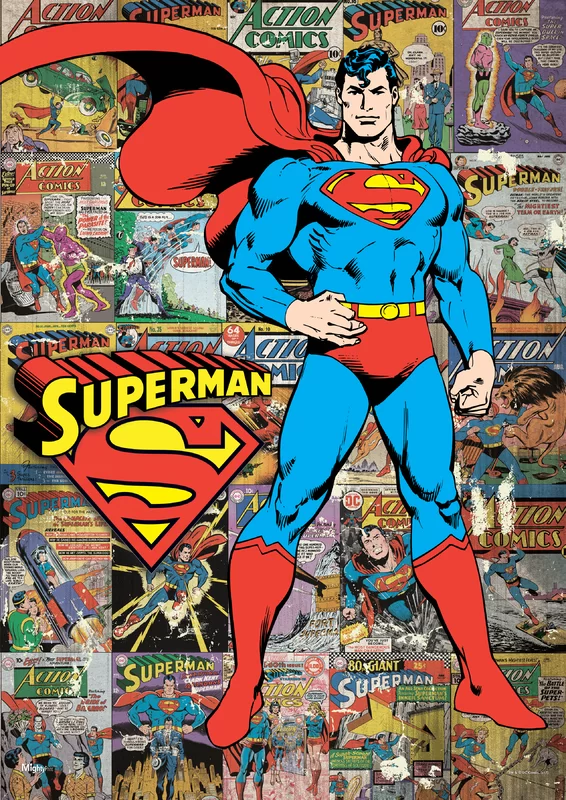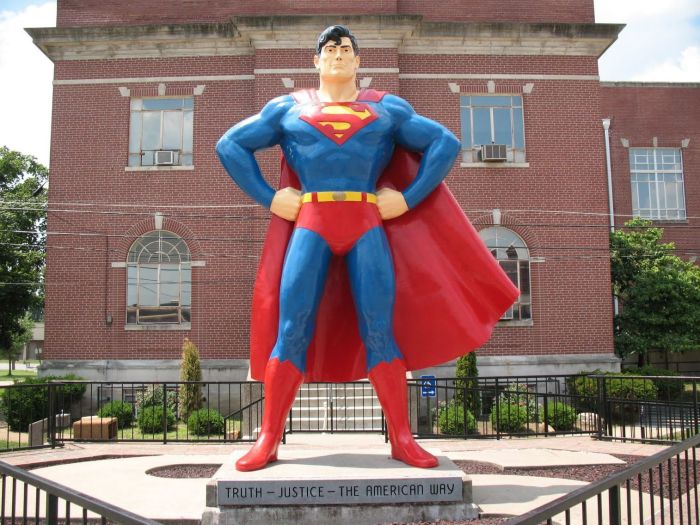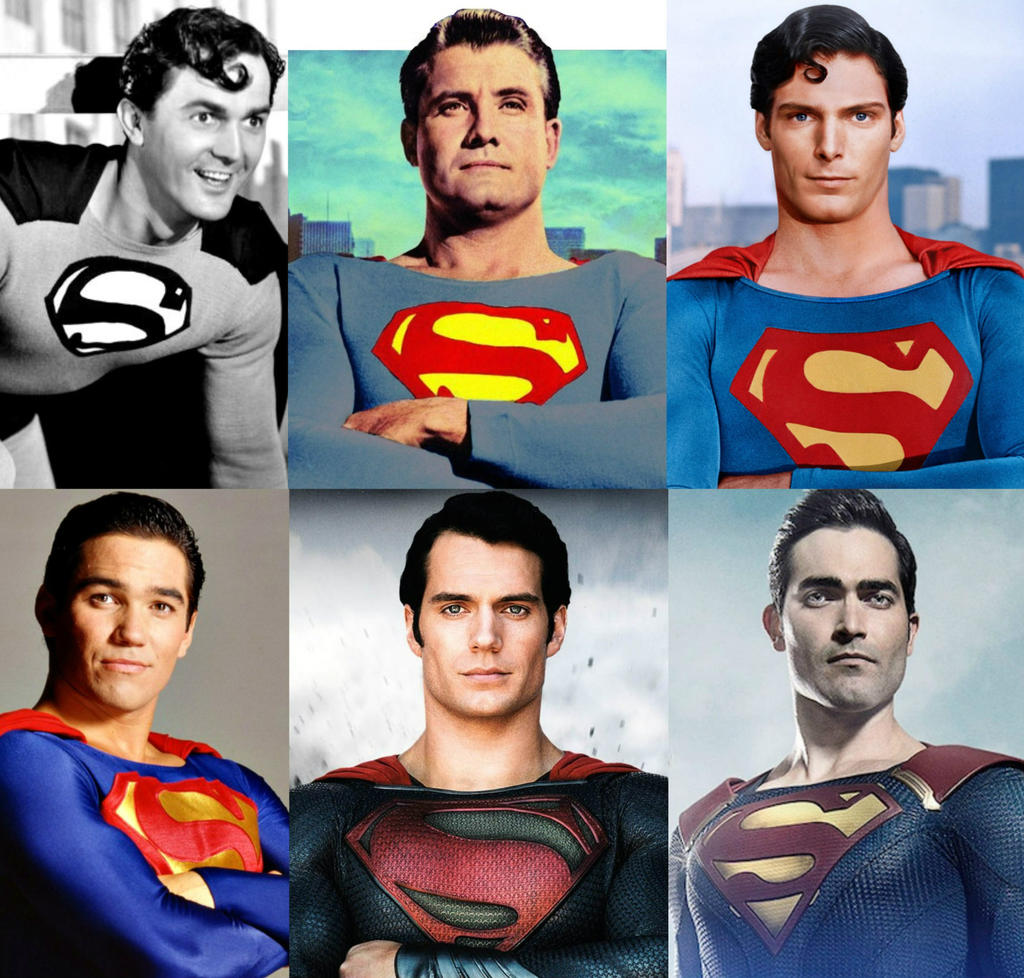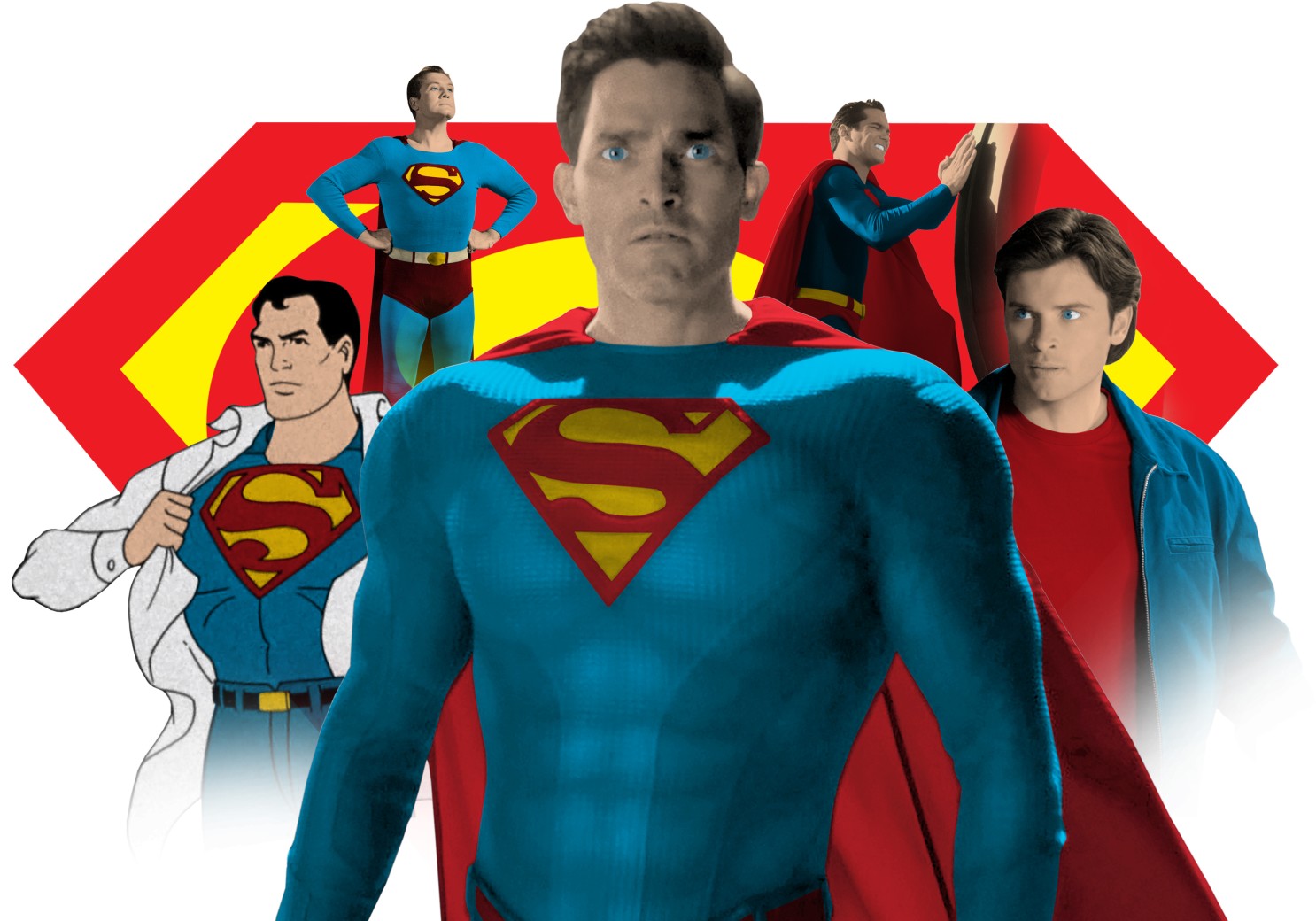
|
|
The Adventures of Superman
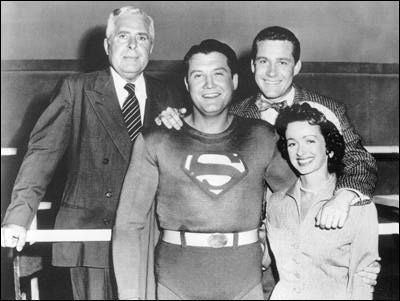
Adventures of Superman was the first television series featuring the comic book superhero Superman. The series, which was syndicated rather than being tied to a network, began filming in 1951, and was first aired on September 19, 1952. The final first-run episode was broadcast on April 28, 1958. George Reeves starred as Clark Kent/Superman with Phyllis Coates as the original Lois Lane. In 1953 Noel Neill, who had previously played Lois in two serials, replaced Coates from the second season onward. Jack Larson played Jimmy Olsen and John Hamilton was Perry White. Robert Shayne played the semi-regular character Inspector Henderson of the Metropolis Police Department.
The opening narration of the show, expanded from that of the 1940s radio show and the Superman cartoons, was dramatically voiced by Bill Kennedy and framed by the show's dynamic theme music which set the stage for each program:
"Faster than a speeding bullet! More powerful than a locomotive! Able to leap tall buildings at a single bound! ("Look! Up in the sky!" "It's a bird!" "It's a plane!" "It's Superman!")... Yes, it's Superman ... strange visitor from another planet who came to Earth with powers and abilities far beyond those of mortal men! Superman ... who can change the course of mighty rivers, bend steel in his bare hands, and who, disguised as Clark Kent, mild-mannered reporter for a great metropolitan newspaper, fights a never-ending battle for truth, justice, and the American way!"
Series Production
The show was originally syndicated. A total of 104 half-hour episodes were filmed, with the first two seasons (26 episodes each) in black and white. Reeves' Superman costume was brown (for red), grey (for blue), and white (for yellow), so that it would "read" in appropriate gray tones on black and white film. As a hedge against the eventual introduction of color TV broadcasting, the show switched to filming in color for the 1954 season onward, though it was initially broadcast monochromatically. This rendered the gray tones of Reeves' new blue and red costume nearly indistinguishable.
The budget for the series was relatively low; the series' actors were paid $200 per episode. TV historians and Jack Larson state that the cast had to make repeated requests to the show's producers before they were given a $50 raise, or else they would quit production. By the end of the run, star Reeves was making at least $2500 per episode, but the rest of the cast still made considerably less. The stars were signed to a "run of the show contract," meaning the producers could demand their services to shoot a new season within thirty days' notice. However, this clause also prohibited them from doing any long-term commitments like movies or plays.
The series was filmed like movie serials in that the principals wore the same costumes throughout the show to expedite out-of-sequence shooting schedules and save budgetary costs. For instance, all scenes that took place in the "Perry White Office" set would be filmed back to back, for future placement in various episodes, which was often confusing to the actors.
Series History
California exhibitor and B-movie producer Robert L. Lippert released a feature called Superman and the Mole Men in 1951, effectively being a pilot episode for the series. The film was a hit with audiences, prompting the first season to go into production, but the series itself remained unseen until 1952-53, when Kellogg's agreed to sponsor the show, as they had previously done with the Superman radio series. [Grossman, page 59-64; Henderson, no page cited). The "Mole Men" feature was divided to create "The Unknown People", the only two-part story of the series. Seldom seen after its initial release, the film reappeared in the 1990s on cable television and home video; it is now part of the DVD issue of the first season, and is on the 2006 DVD release of Superman: The Movie.
The first season's episodes were filmed in 1951, but major confusion has always reigned regarding the copyright dates. When the series was syndicated in the early 1960s, film editors frequently spliced the 1951 title and intro onto second-season episodes. Likewise, all the episodes from the third and fourth season frequently had opening Adventures of Superman title cards that had 1957 copyrights on them. The DVD release compounds this confusion by exclusively using the first-season titles on all of the first and second season episodes, and retaining one 1957 title card on all 52 color episodes (the actual copyright date appears at the start of each of the closing credits).
As a syndicated show sold separately in every market, Adventures of Superman did not have a proper "premiere" date. It was first seen in Los Angeles on KECA (now KABC-TV Channel 7) on February 9, 1953; it first showed in New York on April 1, on WABC. (Grossman, p 65). IMDB, notorious for miscalculations in dates, states that its official debut was September 19, 1952, but this date is unsourced.
As the series progressed, the style and content differed significantly:
Episodes 1-26: (Black and white) Considered by many fans as the best (and certainly the most serious) of the series, these noir-ish films resemble theatrical action-adventure serials and crime melodramas of the 1940s. The supporting casts are filled with established movie character actors, heightening the resemblance. Phyllis Coates, like George Reeves, was a popular lead in B features of the period. For the TV series, Reeves suggested that Coates receive equal star billing. Coates created a sharp, strong-willed Lois Lane, enterprising reporter who tries to outscoop Clark Kent. Jack Larson presents Jimmy Olsen as a Daily Planet intern always investigating the truth behind something wrong, but being caught by the villains. He usually receives help from Superman in the nick of time. Superman himself is seen as a semi-mysterious presence, unknown to many of the crooks ("Who's the guy in the circus suit?" asks a villain in "The Riddle of the Chinese Jade"). The shows are typically action-packed, gritty, and often violent storylines in which Superman fought gangsters and crime lords. There were a number of deaths both on- and off-screen.
Episodes 27-52: (Black and white) The series had discontinued production until the producers found a national sponsor for the 1953 season. When it came time to reassemble the cast and crew for new episodes, Phyllis Coates was no longer available, having committed to another project. The producers then hired Noel Neill, who had played Lois Lane in the two Superman serials, and gave her secondary billing with Larson, Hamilton, and Shayne. Neill's portrayal was more accessible to the younger TV audience, sweeter and more sympathetic than the efficient, hard-as-nails Coates characterization. The second-season shows were generally serious in nature, with the violence tempered significantly, although there was still the occasional death of a villain, usually off-screen. Sentimental and/or humorous stories were more in evidence than in 1-26. A large portion of the stories, however, dealt with Superman's personal issues, such as his memory loss in "Panic in the Sky" (see below).
Episodes 27-52: (Black and white) The series began to take on the lighthearted, whimsical tone of the Superman comic books of the 1950s. The villains were often caricatured, Runyonesque gangsters, played with tongue in cheek. Violence on the show was toned down further. The only gunfire that occurred was aimed at Superman, and of course the bullets bounced off. Superman was less likely to engage in fisticuffs with the villains. On occasions when Superman did use physical force, he would take crooks out in a single karate-style chop or, if he happened to have two criminals in hand, banging their heads together. More often than not, the villains were likely to knock themselves out fleeing Superman. Now very popular to viewers, Jimmy was now being played as the show's comic foil to Superman. A lot of the plots had him and Lois being captured, only to get rescued at the last minute by Superman.
Episodes 27-52: (Color) Scripts for the last season did not hit the campy lows of the previous two years and reestablished a bit of the seriousness of the show, often with science fiction elements like a Kryptonite-powered robot (a left-over prop from "The Bowery Boys Meet the Monsters"), atomic explosions, and impregnable metal cubes. In one of the last episodes, "The Perils of Superman" (a takeoff on The Perils of Pauline), there was indeed deadly peril straight out of the movie serials: Lois tied to a set of railroad tracks with a speeding train bearing down on her, Perry White nearly sawed in half while tied to a log, Jimmy in a runaway car headed for a cliff, and Clark Kent immersed in a vat of acid. This was one of three episodes directed by George Reeves himself, in an attempt to inject some new life into the series. Noel Neill's hair was dyed a bright red for this season, though the color change was not apparent in the initial black-and-white broadcasts. Although Reeves' s efforts did not save the series from cancellation, "Perils of Superman" is regarded as one of the best episodes.
Villians & Character Actors
Neither Lex Luthor, Brainiac nor any of the regular comic book villains were used in the TV scripts, although a midget Martian, "Mr. Zero" (Billy Curtis) bore a vague similarity (in relative size only) to the comics' magical imp and recurring Superman villain Mr. Mxyzptlk. Carrying over the precedents established in previous electronic media productions of Superman, the bad guys on the TV show were usually generic thugs, evil scientists, Russian agents, crooked businessmen, or spies of fictitious foreign countries. Since the producers never expected the audience to view one episode more than once a week, character actors like Tris Coffin would often be hired as government agents one week, sleazy gangsters the next week. Herb Vigran and Ben Welden made multiple appearances over the course of the show, always as different characters. One of the most recognizable repeat performers was Sterling Holloway, the honey-throated actor best known as the voice of "Winnie the Pooh." Other players who landed a Superman episode early in their careers included Chuck Connors (later star of The Rifleman), John Beradino (long-time star of General Hospital), Billy Gray (Father Knows Best), Claude Akins (BJ and the Bear), Vic Perrin (the "Control Voice" of The Outer Limits) and Dabbs Greer (the preacher in Little House on the Prairie). Director Tommy Carr's brother Steve appeared as an unbilled extra in nearly every one of the first 26 shows (he was also the show's assistant director, and was the man pointing "up in the sky" in the black-and-white intro). In "Czar of the Underworld", he played a movie director, and was even called "Mr. Carr" by the other characters.
The final episode of the series, "All That Glitters", concludes with a line that turned out to be much more darkly ironic than its writers could have anticipated. The episode features a dream sequence in which Jimmy and Lois acquire super powers. Back to reality, at the end of the show, Jimmy says to Clark, "Golly, Mr. Kent, you'll never know how wonderful it is to be like Superman!" Clark responds, "No, Jimmy, I guess I never will." One year after the episode was broadcast, the most-beloved icon of the show would leave many in shock and without a hero.
Visual Effects
While considered simple by today's standards, the "flying" effects on The Adventures of Superman were advanced for that day and age. In the two Superman serials of the 40s with Kirk Alyn, the flying scenes consisted of the actor Kirk Alyn jumping up and turned into a cartoon character as he flew away. Many were upset that they never actually saw the actor fly, but this would be improved later for the series.
Several approaches were used to emulate the "takeoff" portion of Superman's flying. For Superman and the Mole Men, Reeves was suspended by cables while they were rigged to make it look like he was flying. This was not particularly effective, as sometimes his legs would dangle and wobble a bit, but it was regarded as a major improvement over animation. Sometimes powerful fans were used off-camera to add apparent realism to the takeoffs. Reeves often performed the stunts himself in lieu of a stuntman, although stuntmen were sometimes discerned on some of the early takeoff shots. After Reeves nearly suffered a concussion during one take of the episode "Ghost Wolf", when the wires suspending him suddenly broke, he declared he wouldn't "fly" like that again, according to Gary Grossman. All future take-offs after that were accomplished using a springboard: Reeves would run into frame, hit the out-of-frame springboard (or "diving board" as Jack Larson called it) which would boost him out of frame (sometimes over the camera), and onto padding. The springboard had enough force, along with subtle camera manipulation, to make it look as though he was actually taking off. In a few episodes, the spring board can be seen springing up into the frame following Reeve's ascent. This technique was much more effective, as well as being safer, and was used through the remainder of the series.
The flying scenes were accomplished through a relatively small amount of stock footage that was used repeatedly, although the set of that footage was redone for each of the three distinctive periods of the series. The typical technique, referred to by Gary Grossman as the "swish-pan" shot, had footage of Reeves stretched out on a spatula-like device (referred to by crew as the "flying pan") formed to his torso and leg, operated on a counterweight like a boom microphone. Usually, wind-fans would provide the wind for the illusion of pushing through the air. Reeves was occasionally filmed in front of aerial footage on back-projection screen, or against a neutral background which would provide a matte which would be optically combined with a swish-pan or aerial shot. That footage was matted onto various backgrounds depending on the needs of the episode: clouds, buildings, etc. that he would appear to fly by. In later episodes during the color seasons, special flying shots needed for specific shows would be shot simply, with Reeves prone on the flying rig against a light blue cyclorama, or black backing, depending on requirements of the script.
Techniques for the landings involved Reeves jumping off a ladder or holding a horizontal bar and swinging down into frame, landing on the floor. Because he was already an athlete, Reeves was able to perform the stunts without much "stutter-stepping" and immediately deliver his dialogue without sounding "out of breath", avoiding the need to cut to another angle or scene.
The production and special effects team mostly consisted of B-movie workers and serial cameramen, who simply treated each episode as a 25-minute B-movie. Although Reeves did many of his own stunts, there are moments in some of the early black-and-whites, in which fisticuffs were much more common than in later episodes, where a stunt man can be seen in the wider-angle shots, as in the first season episode, "No Holds Barred," for example. In the 1950s, long before large-screen TV's and video-recorders, that likely would have escaped the viewers' notice.
Locations
The establishing shot of the "Daily Planet Building" in the first season was a single piece of footage of the E. Clem Wilson Building (at left) at 5225 Wilshire Boulevard in Los Angeles, California, a famous example of Streamline Moderne architecture. Entrances/exits made by "the Daily Planet staff" were filmed two blocks east at the Carnation Milk Company Building (5045 Wilshire - at right, address number partially visible). Some sources mistakenly label the Wilson Building as the Carnation Building. The Wilson Building still exists. The Carnation Building was altered or demolished some years ago. For episodes 27-104, various stock clips of the Los Angeles City Hall stood in for the Planet building, as by the time production resumed in 1953, a large billboard for General Insurance Company was wrapped around the spires of the Wilson Building. One oft-used City Hall clip showed 1950s cars streaming along the nearby Hollywood Freeway (U.S. Route 101). The actual sidewalk and doorway to the Planet then was a studio-bound "exterior."
The first 26 episodes featured many exterior shots, often at the RKO Pictures backlot called "Forty Acres", the same buildings later used on The Andy Griffith Show. A coincidental connection between those two shows is that occasional Superman guest player Dick Elliot also played the mayor of Mayberry in some of its early episodes. During the first and second seasons, hillsides nearby in Culver City or residential neighborhoods of the San Fernando Valley were occasionally used for exteriors. In later seasons, the episodes tended to be filmed mostly on soundstages, with most obviously exterior shots (such as cars driving along roadways) being generic stock footage, though some later episodes contained scenes shot on Los Angeles city streets (e.g., "The Big Freeze" from 1955).
Another favorite Los Angeles stock-footage landmark was the Griffith Observatory, which had several different "cameos" in the series, ranging from Jor-El's Kryptonian laboratory in "Superman on Earth" to, appropriately, the Metropolis observatory. The view of the observatory was typically similar to the perspective shown here, from a walkway below the complex.
Aside from a few clips of New York City in "Superman on Earth", most if not all of the stock clips used to depict Metropolis are from the Los Angeles area.
